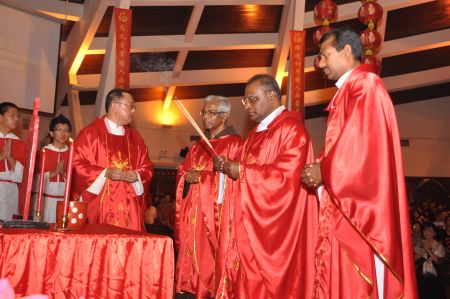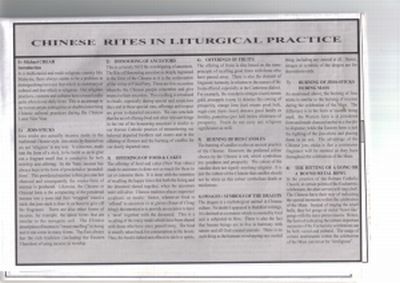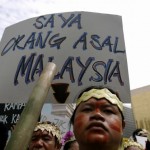venerating (not worship) our ancestors
 refer to my photo blog on komunitikini entitled 'cultural twist to CNY service'.
refer to my photo blog on komunitikini entitled 'cultural twist to CNY service'.
gee i just find out two days ago that this post of mine in komunitikini received so many comments and likes. think by far, this is the most no. of comments for my photo blog/articles in komunitikini. my other photo blog/articles mostly did not have comments at all or if there were comments, there will be only 3 or so. i guess it is expected that if we put up controversial issues, there will be lots of feedback.
okay before i give my personal view of what i'm going to talk about – THE RITE OF COMMEMORATION (OR VENERATION) OF ANCESTORS – performed after the chinese new year (CNY) mass, first i'm giving an overview of the rite.
————————————————————————————————————–
The Rite:
Every year, during the Lunar New Year, there will be Masses around the churches in Malaysia for Chinese Catholics. Apart from the usual liturgy for the Mass, several churches will include the Rite of Commemoration of Ancestors. Most of the churches in Penang did this during the CNY eve Mass.
An ancestral table will be set up at the side next to the altar, where a ‘Ancestral Tablet’ was placed on the table.
This Rite had been a source of controversy all the time as there were differing views that it should or should not be allowed.
Many priests do allow the Rite. In the beginning, it was done after the post-communion prayer but as more people complained that it should not be part of the liturgy, now it was done after the final blessing and dismissal.
The Rite of Commemoration of Ancestors began with intercessory prayers, where the first few prayers were directed at the ancestors, departed family, relatives and friends.
Next to the main altar, a table will be set up, where the ancestral tablet is placed there.
After the prayers, the altar boys light up three joss-stick and hand them over to the celebrant. On behalf of the congregation, the celebrant raises the joss-sticks with both hands to the height of his forehead, as a sign of honoring the ancestors. Then he place the joss-sticks into the holder, which is placed a the table (where the ancestral tablet is – let's just refer to it as 'the ancestral table').
The congregation is then called to bow three times to the ancestral tablet.
This is followed by the offering of gifts. All the gifts offered are symbolic in meaning.
Two baskets of flowers, symbolize love for ancestors. Three cups of wine to symbolize remembrance to ancestors, and two tray of fruits to symbolize admiration for ancestors.
These are the three basic gifts but in some parishes they also add some other gifts like red candles to symbolize hope and peace, ‘Nian gao’ (a kind of Lunar New Year sticky cake) to symbolize unity and fellowship.
Mandarin oranges, a must-have during Lunar New Year, are then bless and pray over. The oranges symbolize peace, happiness and prosperity.
Then came the New Year Greetings. Congregation were called to kneel and bow three times as a sign of worship and thanksgiving to God. They then stand and first, bowed to the celebrant and then to each other.
Finally, they came forward in line to receive ‘Angpow’ (red packet filled with cash) from the celebrant and the blessed orange from the wardens.
In some parishes there will be a lion dance performance and letting off of fire-crackers, after the whole thing is over.
The Rite of Commemoration of Ancestors had been approved by Pope Pius XII in 1939. This 1939 instruction, is known as “Plane compertum est” . It declared that rituals performed on the occasion of funerals or commemoration for the dead are conducted to demonstrate honour and respect to the ancestors.
————————————————————————————————————–
my say/view:
what i'm gong to write here will be my own personal view. i'll be writing whatever come out of my mind so there might not be a smooth or continous flow. never mind as i'm not writing for a publication/media. i'm writing for myself in my own blog. that's the good thing about it. i can say anything i like without fear of stepping on people's toes. er… well… i might step on people's toes but they are always welcome to make some comments or more serious, make disclaimer if they think i misquote them or what. but no, most probably i'm not going to quote people. i will mention what some people say but without names, so as the saying say 'siapa makan cabai, dia rasa pedas!' (he/she will know it if i refer to her/him).
well, i'm going to talk about THE RITE OF COMMEMORATION OF ANCESTORS which is done every year AFTER the chinese new year mass in church.
some people don't understand, they thought we are worshiping our ancestors when we have this RITE OF COMMEMORATION OF ANCESTORS during the CNY mass. we are NOT. we are honoring our ancestors (or commemorate them, see, the name of the rite). they said we should only worship god and not our ancestors. no, when we performed this rite inside church, it doesn't mean we are worshipping them with this rite, we are honoring them. we only worship god, not humans, dead or alive. also some don't understand the rite was done AFTER the mass ended… so it is not part of the mass liturgy. (though it had been the norm to say the rite was done during the CNY mass but actually it was after the mass). of course those who are against it will still argue it does not make any difference if it is during the mass or after the mass. well if your mind is already dead set that this rite is wrong, for sure you will say it does not make any difference… but it does if you understand the liturgy and the rite.
personally for me i don't mind this rite being performed after the CNY mass BUT also, to me, this is something we can do without. i mean though i'm all FOR the rite, i'd rather that it is not performed after the CNY mass. this does not means that i'm against it of course. i'm all for it but i just thought it is not necessary to have it in church after the CNY mass… but at the same time i'm not saying it is wrong… unlike others who feel it is wrong and quick to condemn and criticise.
still there are others who said people don't honor their ancestors at home, why do they want to honor their ancestors in church during CNY? well i would say, that's precisely the reason. they don’t it at home so need to do it once a year in church. just like we have a valentine’s day, a mother’s day, a father’s day. they need one day in a year to remind them. see, they are obligated to go to church every sunday and receive holy communion. they only receive holy communion in church… not when they are at home, so it doesn't mean that what they don't do at home (take communion), they should not do it in church.
as chinese, to us filal piety is important, thus many chinese will want to honor their ancestors during this special day – the CNY. yes sure we can honor our ancestors when we go to their graves, like on all souls day… but on all souls day we are honoring our ancestors individually as a person or as a family. it is not communal. see, people will say too that you can always pray at home, why need to go to church to pray? we go to church to pray to gather together as one big community – it's a communal prayer we involved in. likewise, yes, we can honor our ancestors at home (regularly or whatever), we can honor our ancestors during all souls day but we are doing all these as individuals. so during the CNY mass, it will be an appropriate time that for once do this honoring of ancestors as a community.
of course some will argue that honoring our ancestors is something personal and we should not do it together as a community. well yes true… if you see it that way. yes the truth is there is no right or wrong answer. there are just different opinion from different people.
then there's this thing about joss-sticks. many people seems to go into a shock when they see the priests (or catholics) holding joss-sticks. why? to them, they think joss-sticks belongs exclusively to the buddhists (or taoist or… confuciousnist?). only the buddhists use joss-sticks to pray. if catholics hold joss-sticks then it is consider sacrilege or what. come one lah, just as you made noise about the word allah is not exclusive to the malaysian muslim (where catholics should be allowed to use), joss-sticks are not exclusive to buddhists. a joss-stick is merely an INCENSE ON A STICK. so anybody of any faith can use a stick to burn incense during their prayers. geddit?
whether one is FOR or AGAINST this rite, it doesn't make any difference to the person's faith, like making you less a catholic if you are against it, or maybe more of a catholic if you are against it? simply because this is only a rite of commemoration of ancestors, nothing to do with liturgy, with worshipping god.
one thing i notice that most of those who are against this rite will be the converts (not born christians) or the 'deserters' (sorry for want of a better name, don't know what else to use)…. those who like what we label our politician as 'frog'… who jumped from one denomination to another. or those who are english educated. do they feel ashamed of their own chinese roots… to show their chinese tradition? of course the argument will go on and on… no they are not ashamed, they just feel the rite should not be done in church, blah blah blah. yes, their own view… but i'm also expressing my own view here!
some people argue that having this rite in church will send the wrong signals to others (esp. non christians) who happened to witness it (live or on photos). they will think catholics are pagan worshippers or what… but hey haven't they heard of education? it's our duty then to educate them why it is not wrong. uh oh but they they will want to educate those who are for it, why it is wrong! well as i said there are no wrong or right answers actually, only views here and there. so i'd better quit talking about this now as even if i talk until the cows (not sharizat cows) come home, it won't end. however, i would like to post here some information i found from the net here and there just for the record in my blog.
UPDATED: click on the small pic below to read it in bigger size – chinese rites in liturgical practise, explained by our local priest, fr. michael cheah.
====================================================================
taken from the net. (to be updated)
ANCESTORS’ VENERATION
1. Ancestors’ veneration refers to those rituals that are performed in order to express honour or respect for the deceased by the family members. In those rituals, filial piety is, and always has been, at least to some extent, the motivating factor.
2. On December 8, 1939, the Congregation for the Propagation of the Faith issued a decree allowing Catholics to participate in ancestors’ veneration.
3. This 1939 instruction, known as “Plane compertum est” was approved by Pope Pius XII. It declared that rituals performed on the occasion of funerals or commemoration for the dead are conducted to demonstrate honour and respect to the ancestors. It also stated, as a general acknowledgement: “Today, it is clear that, in the East, some ceremonies, although of great antiquity and originally connected with pagan rites, nowadays, on account of changing customs and ways of thinking, have come to have a merely social significance, out of respect for one’s ancestors…”
4. Vatican II (1962 – 1965) called for the recognition of the native genius of each and every culture throughout the world as expressed through their indigenous traditions. It went beyond simply permitting Catholics to participate in native traditions, such as is allowed in “Plane compertum est” for Chinese ancestral rites:
– The Decree on the Missionary Activity of the Church “Ad Gentes”, for instance, advised native Catholics to imbue their national treasures with the Christian message.
– The Constitution on the Sacred Liturgy “Sacrosanctum Concilium” called for the creation of new rites within the Catholic Church to express clearly the view of a particular race or culture. (“Inculturation” is the term used to describe these processes.)
5. On July 18-19, 1964, seven Chinese bishops in Taiwan, had an official meeting with Mgr. Joseph Caprio, Pronuncio, and unanimously agreed to issue the following instructions on Ancestors’ Veneration:
- In remembrance of the deceased, the setting up of a tablet (bearing his name without the addition of superstitious inscriptions) by the family members is no longer forbidden.
- It is allowed to bow or prostrate in front of the ancestor tablet, photograph or coffin.
- Offering of fruits or food in front of the ancestor tablet or at the grave is no longer forbidden.
- Burning of joss papers for the deceased is forbidden, because of its superstitious character.
6. Based on these instructions, liturgical texts, known as the “Proposed Catholic Ancestor Memorial Liturgy for Church and Family use” were issued by the Chinese Bishops’ Conference in Taipei, Taiwan, on December 29, 1974. These liturgical texts combined Catholic tradition with ancestor veneration.
These texts are probably available in Singapore in Chinese. A proper English translation of them should be made, for a wider use in our churches…
From the Liturgy Commission of Hongkong (thanks to Fr. Henry Siew), here is how the Memorial Rites for Ancestors are conducted (according to liturgical books published):
– Such memorial services can be held on All Souls, Quing Ming Day, Lunar New Year, after the Mass.
– An appropriate table is set up, with a Crucifix, an ancestors’ tablet, fresh flowers, candles & incense bowl.
- All bow once to the ancestors’ tablet at the beginning of the rites.
- The main celebrant or the head of the family gives instruction on the meaning of the remembrance.
- Intercessory prayers.
- Offering of gifts: flowers, fruits, wine.
- Offering of incense. If the group is small, all participants will offer incense in order of seniority.
- Final prayer.
- The whole assembly offers three bows.
A document from the Office of the Apostolic Visitor, Singapore, dated 4th Nov. 1958: “Propositions and Directives regarding the recent Instructions on the Sd. Congregation of the Propagation of the Faith on the Subject of Chinese Rites”, gives a summary of the Chinese Rites controversy and its solution.
Although pre-Vatican II, the guidelines it gave then are still relevant today. For example:
“Aims of the Church’s change of attitude regarding the Chinese Rites:
– To make known the attitude of the Catholic Church, which is one of understanding and interest towards all human cultures, provided that their manifestation be not intrinsically evil.
– To show, in a tangible way, that Catholics have a respect for traditions and preserve their civic and social qualities, the deficiency of which would be an obstacle to conversions.
– To facilitate the admission of converts into the Catholic Church, by permitting them
a. to observe family rites (for example, showing marks of respect to ancestors) so as not to break their ties with their family and relations.
b. to participate in social ceremonies (for example, on the occasion of a funeral) so as not to isolate themselves from the community to which they belong.
Those who have the charge of souls will examine how far the changing customs and ways of thinking have affected the individuals, families and ethnic groups that depend upon their priestly ministry, so as to be in a position to instruct them in conformity with the Church’s teaching. In carrying out this enquiry, it will be necessary to bear in mind that:
The older generation of Christians, brought up in the old discipline, are not the best judges in this matter.
A great diversity in the appreciation of the religious content of the Rites and Ceremonies can be encountered in one and the same family. This appreciation varies even further according to the different provinces of China from which the faithful originally came, and according to the education they have received.
On account of the pastoral ministry of the priest and because of his incompetence in this matter, those questioned may easily believe that it is their duty to reply that the rites are tainted with superstitious practices.
The best opportunity to clarify doubts on these matters is through the confessional and in the course of religious instruction.
Religious Instruction
General instruction in the principles which have guided the Church in her attitude towards the Chinese Rites and Ceremonies. These principles are those of esteem, understanding and sympathy for the traditions and customs of every country, provided they are not bad in themselves. Thus the Church has not the slightest intention or desire of pressing the faithful to “change their ceremonies, rites and customs, as long as they are not manifestly contrary to faith or good morals.”
Particular instruction on such and such a ceremony, whether permitted or forbidden. This teaching must be given in accordance with the mentality of those present on the subject of the religious content of the ceremonies (e.g.: presence of Buddhist monks or Taoist ministers at funerals).
If necessary, these points of moral theology must be clearly explained:
– Superstitious practices and vain observances.
– Active and passive participation.
– The necessity for the participant to make his/her position clear in order to avoid giving scandal.
Taken from:
Liturgy Commission, July 2003
Archdiocese of Singapore
Archdiocese of Singapore
—————————-
The Chinese Rites Controversy, which began in seventeenth century China and largely concerned disagreement amongst Catholic missionary orders as to whether or not participation in ancestor veneration and Confucian rituals should be permitted by the Church, concluded in 1742 with the bull Ex quo singulari which ruled against Catholics taking part in these rites. However, the Church rescinded this decision in 1939 when Plane compertum est allowed such participation by Catholics of Chinese ancestry. Subsequently, in 1974 the Chinese Bishops' Conference in Taipei, Taiwan approved the "Proposed Catholic Ancestor Memorial Liturgy" in which ancestor veneration became an integral part of Chinese Catholic life. Through extensive library research I trace the history of these developments until 1939. After this date, I attempt to construct the history of the performance of the ritual by Catholics mainly in Taiwan and the United States–as well as to reflect on the meaning of the rite in the Catholic context–primarily through interviews and correspondence with Catholic scholars, clergy and parishioners, recorded personal observation of five such ancestor memorial services, and by a survey. I conclude that the ultimate creation and performance of the ancestor memorial liturgy by the Catholic Church is the practical realization of the ideal to renew attempts at worldwide inculturation as set forth during Vatican II in the 1960s.
Further readings
Rite of Veneration of Ancestors
To bow or not to bow














Leave a Reply
You must be logged in to post a comment.